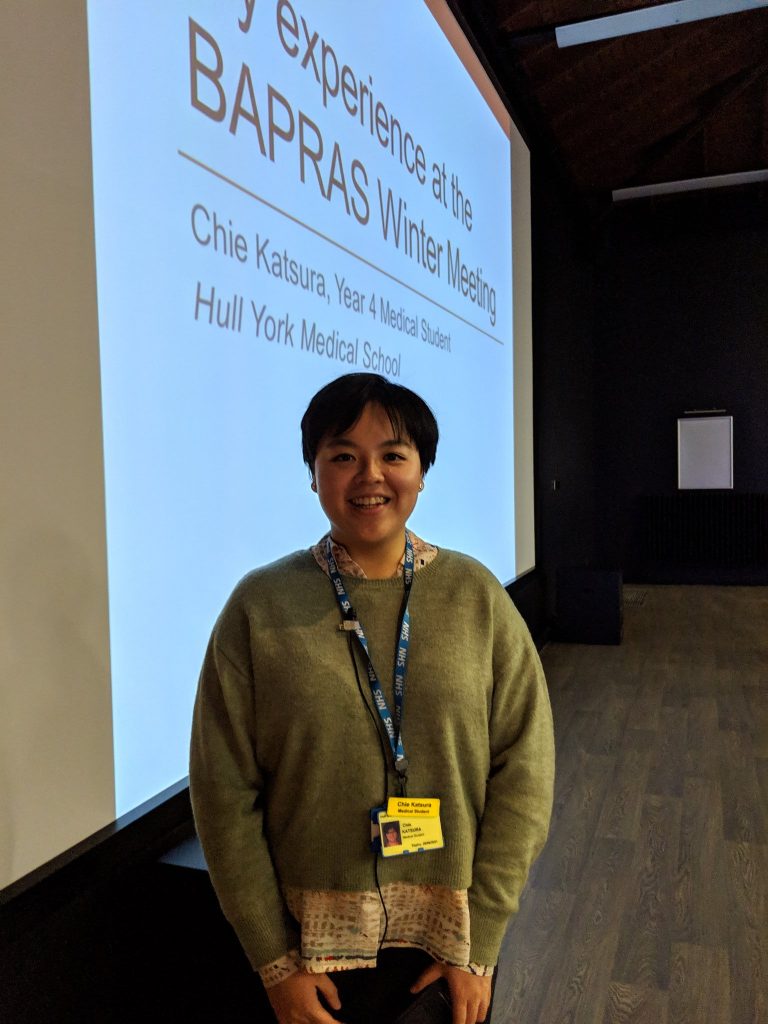On 28th-30th of November 2018, plastic surgeons from all over the world gathered in London for one of the most prominent annual events in the field of plastic surgery, the British Association of Plastic Reconstructive and Aesthetic Surgeons (BAPRAS) Winter Scientific Meeting. I am grateful to the Medly Blog, Hull Medical Society, and BAPRAS for giving me this opportunity to attend this conference. The winter scientific meeting covers the latest high-quality research in all aspects of plastic surgery ranging from burns and limb trauma to breast and craniofacial reconstruction. What I learnt from all the presentations, which were delivered by world-renowned plastic surgeons, was invaluable.
“A Macro approach to Microsurgery.”

Among all the talks, I found Dr Edward Buchel’s presentation on his experience of microsurgical reconstruction to be particularly inspiring. Dr Edward Buchel is a world-renowned Canadian plastic surgeon, who is also on the editorial board of the Canadian Journal of Surgery and Microsurgery. According to Dr Buchel, the plastic surgery department in which he works in Winnipeg, Manitoba covers 80% of all the microsurgeries in the geographic area, i.e. no Maxillofacial/ENT surgeons do microsurgery. Therefore, unlike the current trend where plastic surgeons tend to subspecialise and practice microsurgery in a defined anatomical area, Dr Buchel and colleagues often need to be innovative and learn techniques from other surgical specialties to perform reconstructions all over the body.
One such example that Dr Buchel shared is as follows. A patient, who suffered gallstone pancreatitis, had recurrent laparotomies to the extent that his abdominal muscles and soft tissue were severely destroyed and needed an abdominal wall reconstruction. The reconstruction was bound to be a challenge. In order to reconstruct the abdominal wall, Dr Buchel and his team first had to reconstruct the underlying fascia, which is the foundation for the abdominal muscle wall and the skin. However, due to the vast size of the defect, it was difficult to find any muscle or faciocutaneous free flap of matching size. Here comes the highlight: Dr Buchel and colleagues reconstructed the underlying fascia with porcine dermal xenograft. The team anastomosed the graft to the right gastroepiploic artery, which supplies the stomach. The reason was that the artery has a long pedicle, which allows easy mobilization for reconstruction, and that the stomach has a rich blood supply from other arteries. From this example, Dr Buchel has demonstrated how he approached the area that is traditionally covered by the general surgeons. From there, Dr Buchel raised a rectus femoris neurovascular free flap, which ensured that the muscle is long enough to cover the abdomen. Importantly, harvesting the motor nerve allows this free flap to preserve its motor function. After the surgery and a few years of intense physical rehabilitation, the patient’s outcome was incredible. In the video that Dr Buchel showed, the patient has regained a new abdominal wall, which reliably protects his internal organs. He is now able to perform abdominal crunches with his rectus femoris muscle!
Dr Buchel has demonstrated the importance to be innovative as a surgeon as well as having superior teamwork to accomplish complex reconstructions. Dr Buchel stated that: “Microsurgery is just a tool for reconstructive surgery. The macro approach to look outside of Plastic Surgery and bring techniques from other specialties can be applied in diverse reconstructive situations.”
“Cosmetic Tourism & Complications of Injectable Fillers”
Cosmetic surgery is probably what most people will think of when they hear “plastic surgery”. However, with the rise in cosmetic tourism for cheaper surgery, terrible complications and challenges with managing them become the next big problem. The facts and figures that Miss S Martin and Mr Niall Kirkpatrick presented as part of their experience of managing complications of cosmetic surgery abroad have made me think deeply. I believe that it is important to spread this information across to my fellow medical student colleagues.
As social media has become more influential, we see more people seek to have a ‘perfect’ body. TV channels are launching shows about cosmetic surgery e.g. The Surjury, as well as reality shows that explicitly features young people with ‘ideal figure’. As a result, the NHS is seeing more patients, who went for cosmetic tourism abroad, return with horrible complications. Just recently, The Sun covered a piece of news about a lady who went to Prague for cut-price breast surgery, presented to the NHS with weeping pus from her breasts and lost her nipple. How shocking! This type of news is not infrequent, which reflects how little is known about the potential risks of undertaking these cosmetic procedures.
Did you know that any cosmetic clinics outside the UK are unregulated, even in the EU? Did you know that injectable fillers are not classified as pharmaceutical products in the UK? What all this means is that there is no regulation or trials profile whatsoever for these procedures and products. Hence, their complication rates are not accurately recorded. So how should we tackle this crisis? To conclude, Mr Kirkpatrick and the BAPRAS suggested that the government and regulatory body should tighten the regulation of cosmetic products, and the public need to be educated on this topic!
And Many More
Aside from over 100 cutting edge research presentations and posters, the BAPRAS Winter Scientific Meeting also has a longstanding tradition of inviting UK’s renowned plastic surgeons to deliver eponymous lectures and share their expertise and knowledge in their particular field of practice. This year the BAPRAS council invited Dr Sarah Pape to give the McIndoe Lecture on her experience in burns surgery. This is a memorable moment because it is the first time that a female plastic surgeon received the lectureship! Dr Mark Clemens from the USA was invited for the John Potter Lecture on breast implant associated anaplastic large cell lymphomas. Moreover, the BAPRAS council invited Amazon UK’s head of human resources to talk about Amazon’s career principle and experience in accomplishing high performance team. To summarise, the BAPRAS Winter Scientific Meeting was an amazing, eye-opening and inspiring experience. I would recommend anyone with an interest in Plastic, Reconstructive and Aesthetic Surgery to attend BAPRAS’s biannual winter and summer scientific meetings.
~~~~~~~~~~~~~~~~~~~

Chie Katsura is a final year medical student and the current HYMS local representative of BFIRST charity. She is also an aspiring plastic surgeon and the ex-president of the York Surgical Society. In her spare time, she enjoys cooking and learning new languages
…

Chie presented her experience at the BAPRAS Winter Scientific Meeting on 17th January 2019 to delegates at Hull Medical Society. Her talk was very well received by local health professionals. Congratulations, Chie!

